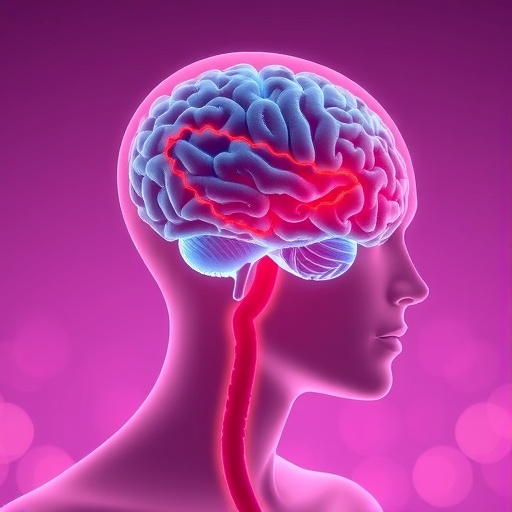In a groundbreaking study that pushes the boundaries of our understanding of eating disorders and metabolic dysregulation, researchers have unveiled compelling evidence linking structural differences in the hypothalamus—the brain’s central regulator of hunger and energy balance—to circulating levels of crucial hormones ghrelin and leptin. This insightful research, recently published in Translational Psychiatry, explores how variations in hypothalamic subregions may underpin the stark biological contrasts observed in conditions such as anorexia nervosa and obesity, offering a nuanced perspective on the neurobiological circuitry of appetite regulation.
The hypothalamus, a compact but complex brain region, orchestrates a symphony of neural and hormonal signals to maintain energy homeostasis, integrating peripheral inputs to modulate feeding behavior. Ghrelin, often dubbed the “hunger hormone,” rises during fasting states, signaling the brain to promote food intake, whereas leptin, produced predominantly by adipose tissue, acts as a satiety signal that suppresses appetite. Dysregulation in these hormones and the brain’s sensitivity to them can lead to pathological eating behaviors, yet the underlying morphological alterations in hypothalamic architecture in such disorders have remained elusive until now.
This study delves deep into the microstructural variations within hypothalamic subregions, utilizing advanced neuroimaging techniques refined to capture subtle morphological differences with unprecedented resolution. By comparing individuals with anorexia nervosa—a condition characterized by self-induced starvation—and those with obesity, typified by excessive adiposity and altered hormonal signaling, the researchers sought to map the relationship between concrete anatomical features and hormone concentrations.
Their findings reveal a striking association: distinct patterns of volumetric differences in specific hypothalamic nuclei correlate with abnormal circulating ghrelin and leptin levels. Notably, in anorexic patients, regions typically responsive to ghrelin were found to be reduced in volume, potentially impairing hunger signaling pathways and contributing to the persistence of restrictive eating despite physiological energy deficits. Conversely, obesity was linked with hypertrophy in leptin-responsive areas, which could relate to leptin resistance—a hallmark of excessive weight gain where heightened leptin fails to suppress appetite adequately.
The methodology employed in this research is particularly impressive for its integrative approach, combining endocrinological assays with high-definition MRI-based morphometry. Blood samples collected from participants provided precise quantitative measures of circulating ghrelin and leptin, allowing for robust correlative analyses against detailed brain imaging data. Such a bidirectional strategy strengthens the inference of causative relationships between circulating hormone levels and structural brain alterations rather than mere associative observations.
Furthermore, this study’s cohort included a spectrum of phenotypes—from extreme anorexia to severe obesity—allowing the identification of a continuum of neurohormonal adaptations. The delineation of these adaptations underscores the plasticity of the hypothalamic circuitry in response to different metabolic challenges, suggesting that the subregional morphological variations might represent either compensatory mechanisms or pathological remodeling, dependent on the energetic state and hormonal milieu.
The implications of these findings are profound for the field of psychiatry and metabolic medicine. First, they underscore the importance of examining brain structure-function relationships in developing targeted therapies. If hypothalamic subregion volumes influence responsiveness to hunger and satiety hormones, interventions could be designed to reverse or mitigate these structural alterations, potentially through neuromodulation or pharmacological agents that restore hormonal sensitivity.
Moreover, the research paves the way for precision medicine in eating disorders. By identifying neuroanatomical biomarkers related to hormone levels, clinicians may better stratify patients, customize treatment plans, and monitor therapeutic efficacy through imaging follow-ups. This approach could significantly enhance outcomes for anorexia nervosa, a disorder notoriously resistant to conventional treatment, and for obesity, which presents a global health burden.
This exploration into the neuroendocrine substrates of appetite control also challenges simplistic views attributing eating disorders solely to behavioral or environmental factors. The neurobiological complexity evinced here invites a holistic consideration of genetic, hormonal, and morphological contributors to these conditions, fostering a more compassionate understanding of their pathophysiology.
Interestingly, the regional specificity in hypothalamic volume changes noted in this study suggests that not all hypothalamic neurons are equally affected in these disorders. This finding opens avenues for future microanatomical studies to characterize the cellular and molecular underpinnings—such as gliosis, synaptic pruning, or neurotransmitter imbalances—that drive these macroscopic changes.
Researchers also highlight the potential feedback loops between hormone signaling and hypothalamic structure. Chronic alterations in ghrelin and leptin concentrations might induce neuroplastic changes, which in turn exacerbate hormonal imbalances, creating a vicious cycle. Breaking this cycle could constitute a novel therapeutic strategy.
These insights gained into the structural neuroendocrinology of feeding behavior deepen our understanding of how the brain negotiates internal energy states with external demands, integrating peripheral signals to maintain organismal balance. Such knowledge is critical in a modern context where metabolic diseases and psychiatric conditions converge, impacting millions worldwide.
Looking ahead, the research team advocates for longitudinal studies to track hypothalamic morphology and hormone profiles over the course of illness and recovery. Dynamic changes in these parameters could illuminate causal pathways and identify windows of opportunity for intervention.
In conclusion, this pioneering work elucidates the delicate interplay between hypothalamic morphology and circulating appetite hormones, situating the brain’s structure as a pivotal player in anorexia nervosa and obesity. By decoding this neuroendocrine interface, scientists are a step closer to unraveling the mysteries of appetite dysregulation and forging paths toward effective, brain-based treatments for these challenging conditions.
Subject of Research: Morphological differences in hypothalamic subregions and their association with circulating ghrelin and leptin concentrations in anorexia nervosa and obesity.
Article Title: Deciphering the association between morphological differences in hypothalamic subregions and circulating ghrelin and leptin concentrations: exploratory evidence in anorexia nervosa and obesity.
Article References:
Collantoni, E., Miranda-Olivos, R., Uğur, S. et al. Deciphering the association between morphological differences in hypothalamic subregions and circulating ghrelin and leptin concentrations: exploratory evidence in anorexia nervosa and obesity. Transl Psychiatry 15, 483 (2025). https://doi.org/10.1038/s41398-025-03708-6
Image Credits: AI Generated
DOI: 18 November 2025




